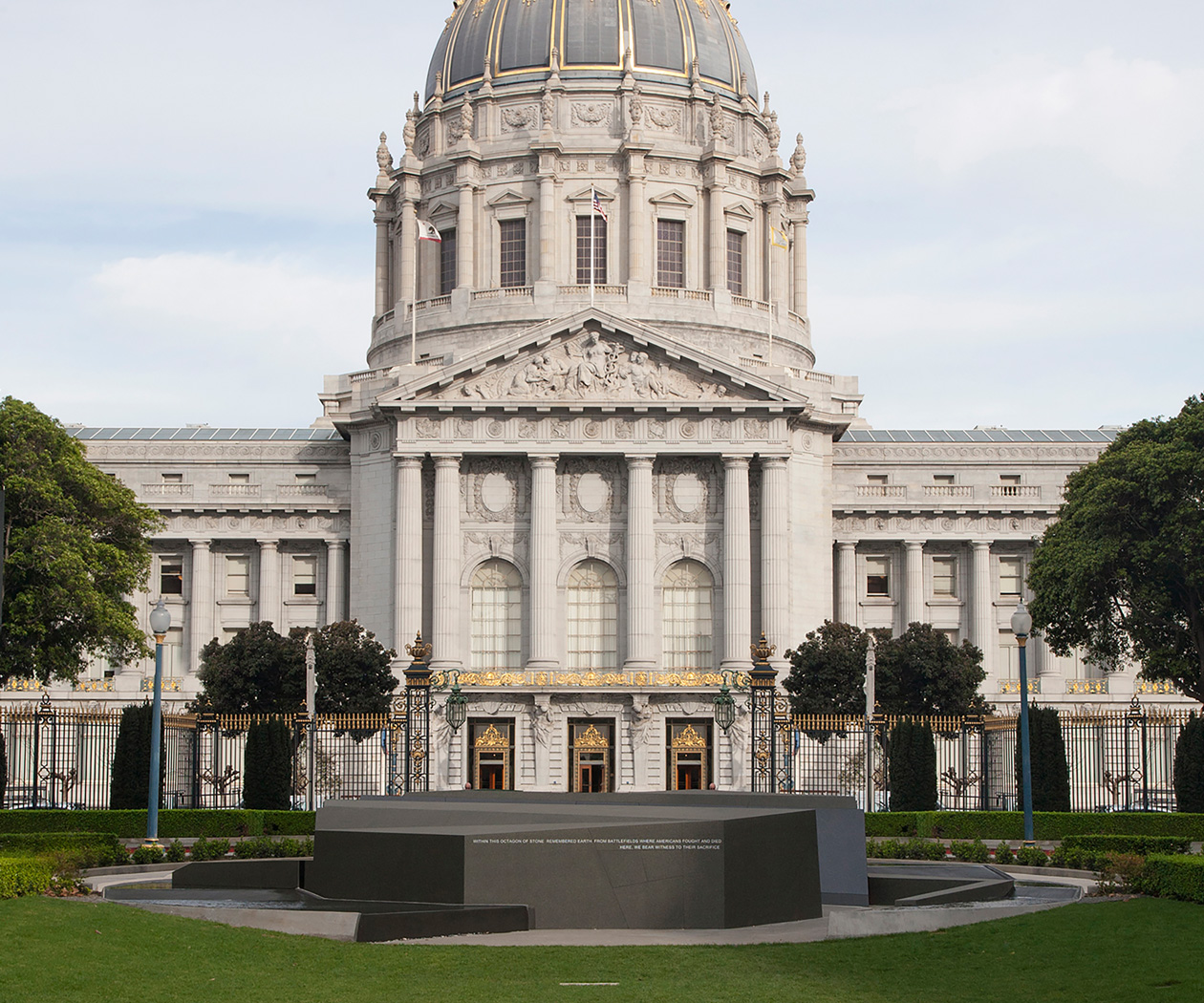
On October 10, 2014, the people of San Francisco dedicated this memorial to our nation’s veterans in honor of their service.
DESIGN STATEMENT ON THE “PASSAGE OF REMEMBRANCE”
by artist Susan Narduli
For half a century, the octagonal lawn in the Memorial Court has served as a little-known repository of earth from lands where Americans fought and died. This stone octagon, now enclosing that earth, is a reflection on memory, within a democracy and amidst the day-to-day life of civil society.
I wanted to create a place that is at once separate from and part of the city. The sloping entrance and the encircling flow of water mark off a place apart, but the city continues to bustle along close by.
The Memorial invites contemplation of what the soil held here means today, what it meant to the men and women who strove for it, what it means for the future, what it means when a democracy goes to war. It’s a personal conversation held in a public space.
The Young Dead Soldiers, the Archibald MacLeish poem engraved in the path through the octagon, continues that conversation between the living and our war dead. They ask for us to give their deaths meaning, to remember. The polished stone captures a visitor’s reflection and the reflections of people nearby, the people charged with remembering and giving meaning.
The Memorial has been designed so that it can be opened to accept newly consecrated earth from battlefields not yet known. This earth will become part of a continuum, with the soil of one battlefield mingling with that of another and, over time, with our own American soil, as the memory of battle filters into our communal understanding.
It is an expression of the bonds of commitment and sacrifice between those who serve, and a statement that our veterans always are and will be of one American people, part of us.
The Memorial Court
AND SACRED SOIL
Today, the heart of the War Memorial Complex is the Memorial Court, a panel of lawn set on axis with the dome of City Hall, flanked by pollarded Plane trees lining recessed pathways in a basket weave pattern of pebble mosaic paving. But when the War Memorial Opera House and Veterans Building opened in 1932, this heart was barren. Funds were so depleted by the construction of the buildings no landscaping had been executed.
It was in 1935 that War Memorial Complex architect Arthur Brown, Jr., recommended landscape architect Thomas D. Church be engaged to complete the Memorial Court. Mr. Church, renowned for his gardens reflecting the Beaux-Arts tradition, set to work and completed the design in 1936. His drawings reference a “future memorial” to be added in the octagonal area of the Memorial Court.
Over the years honor was shown to fallen veterans by interring battlefield soils in the Memorial Court octagon. Soils from World War I battlefields were consigned there at the time of its completion. A similar ceremony depositing soils from World War II battlefields took place following the 1945 signing of the United Nations Charter in the Veterans Building. In 1988, veterans groups held a ceremony interring battlefield soils from Austria, Belgium, Cambodia, China, Egypt, England, France, Germany, Guam, Italy, Laos, Nicaragua, the Philippines, Thailand and Vietnam. And in 2016, parents of fallen soldiers held a ceremony to add soils from Iraq and Afghanistan.
Prior to beginning construction of the San Francisco Veterans Memorial, the soil from the center of the octagonal area of the Memorial Court was carefully removed and safeguarded.
The Passage of Remembrance provides an area within its walls where this soil was re-interred as part of the Memorial’s dedication. Battlefield soils from other conflicts will be added in ongoing remembrance of the courageous men and women who have given themselves in the service of freedom.
The Young
DEAD SOLDIERS
by Archibald MacLeish
The young dead soldiers do not speak.
Nevertheless, they are heard in the still houses:
who has not heard them?
They have a silence that speaks for them at night
and when the clock counts.
They say: We were young. We have died.
Remember us.
They say: We have done what we could
but until it is finished it is not done.
They say: We have given our lives but until it is finished
no one can know what our lives gave.
They say: Our deaths are not ours; they are yours;
they will mean what you make them.
They say: Whether our lives and our deaths were for
peace and a new hope or for nothing we cannot say;
it is you who must say this.
They say: We leave you our deaths. Give them their meaning.
We were young, they say. We have died: remember us.
The Young Dead Soldiers from COLLECTED POEMS 1917 – 1982 by Archibald MacLeish. Copyright © 1985 by the Estate of Archibald MacLeish. Used by Permission of Houghton Mifflin Harcourt Publishing Company. All rights reserved.
San Francisco War Memorial & Performing Arts Center
401 Van Ness Avenue,
Room 110.
San Francisco CA 94102
P: 415.621.6600
F: 415.621.5091
FOLLOW US ON INSTAGRAM
@thesfwarmemorial
FIND US ON LINKEDIN
@thesfwarmemorial


©2024 San Francisco War Memorial & Performing Arts Center. All Rights Reserved.
San Francisco War Memorial & Performing Arts Center
401 Van Ness Avenue, Room 110 | San Francisco CA 94102
P: 415.621.6600 F: 415.621.5091